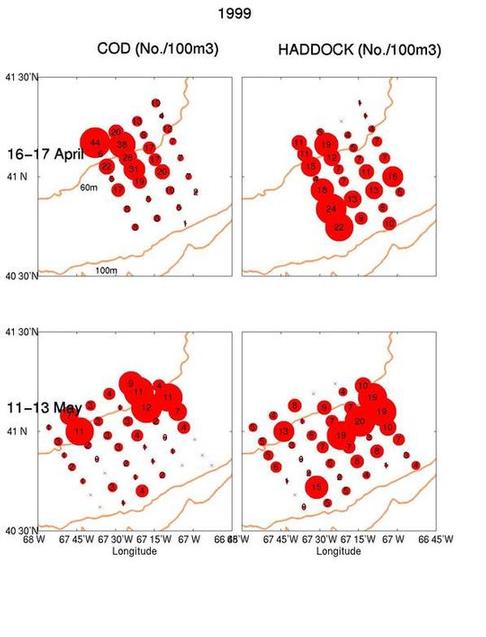Cross-Frontal Exchange and Scotian Shelf Cross-over Workshops
10-12 October, 2000
Holiday Inn, Falmouth, Massachusetts
|
Cross-Frontal Exchange and Scotian Shelf Cross-over Workshops 10-12 October, 2000 Holiday Inn, Falmouth, Massachusetts |
|
Overview
Cross-Frontal Exchange
Presentations
|
Fish Larvae/Zooplankton Studies Larval Fish Process Cruises Lew Incze (BLOS) and Jim Manning (NMFS) We present a quick overview of sampling during the larval fish process cruises during April and May 1999 (EL9904 and EL9905, respectively). These cruises sponsored a number of activities, including larval fish growth and condition, predator sampling, on-board predator experiments, hydrography, currents, nutrients, larval fish distribution and abundance (horizontal and vertical), zooplankton distribution and abundance (horizontal and vertical) and on-board modeling and real-time data assimilation. A summary document is available on-line at www.nefsc.noaa.gov/epd/ocean/MainPage/may99/may99.html. This report should be consulted for details. Here, we focus on timing and spatial sampling patterns as a first-order effect on the availability of data for integrating with other studies and addressing cross-frontal and cross-over questions. Both cruises focused on the tidal front at the Schlitz mooring array (7 moorings from the 58-70 m isobaths, crossing the 60 m isobath at approximately 41°09.00´N, 67° 18.00´W). For cross-frontal movement, the important data sets will be (in addition to the Current Meter array): the CTD, drifter and ADCP data (J. Manning); MOCNESS (G. Lough); and zooplankton pump profiles (L. Incze). Larval fish and zooplankton samples were collected at various times of the day/night cycle to capture diel migrations and other behavior (such as feeding). MOCNESS was equipped with 333µ m mesh and sampled at 10 m intervals. Zooplankton collected with the pump system were retained on 43µ m mesh and were sampled at 5 m intervals from 5m down to 50 or 55 m depth. The MOCNESS and zooplankton pump profiler were both equipped with CTDs, fluorometers and PAR sensors. Both cruises began with bongo/CTD grids (total of 231 CTD casts). These were not as extensive (along-shelf) as in some past years, but they extended from the mixed area nearly to the 100 m isobath. The bongo was equipped with 333 µ m mesh nets and towed double-oblique fashion to near bottom. Large numbers of cod and haddock larvae were available, probably more than in any of the other major process cruises (1995 and 1997). Typical of most other surveys, the cod were more abundant in the inner part of the survey area and haddock were more abundant in the outer half. Figure 1 shows both the distribution of bongo/CTD stations and the preliminary concentrations of cod and haddock larvae.
In addition to met sensors, the on-board ship sensor package included continuous monitoring of near-surface temperature, conductivity and fluorescence. Dates for the activites highlighted above are: Bongo/CTD grids: MOCNESS and Zooplankton Sampling around the tidal front: Cross-front CTD transects, with ADCP in May: Drifter deployments: |